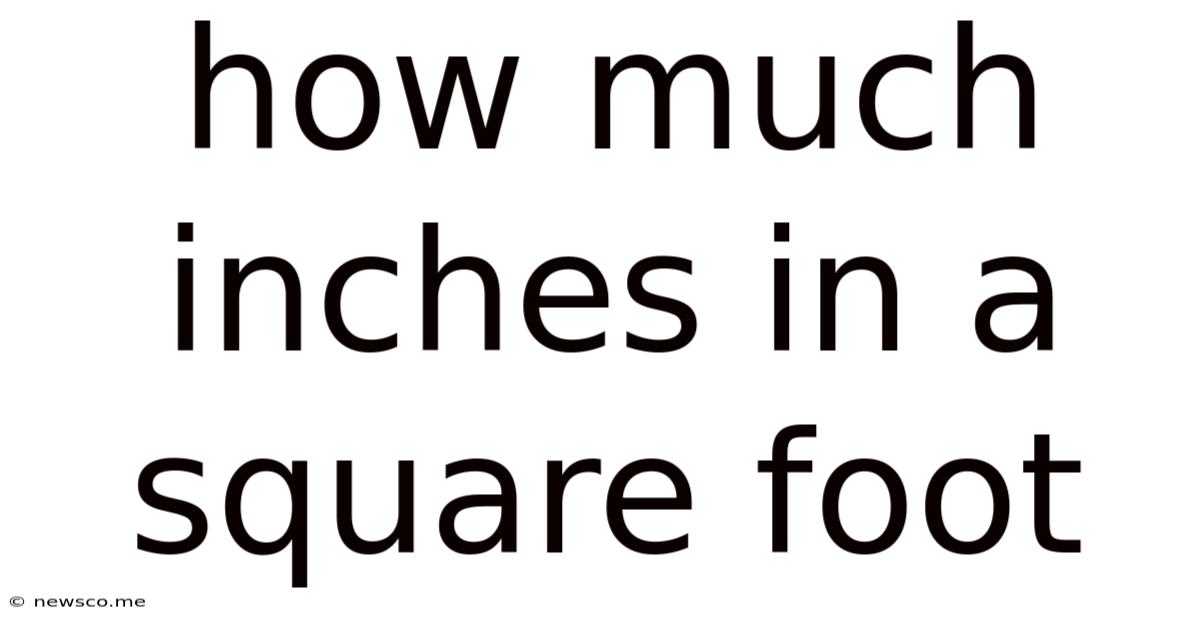How Much Inches In A Square Foot
News Co
Apr 04, 2025 · 5 min read

Table of Contents
How Many Inches Are in a Square Foot? A Comprehensive Guide
Understanding square footage is crucial for various tasks, from home improvement projects to real estate calculations. While we often deal with square footage in everyday life, the question of how many inches are in a square foot often leads to confusion. This comprehensive guide will not only answer that question but also delve into the related concepts, offering practical applications and clarifying common misconceptions.
Understanding Square Footage and Square Inches
Before we jump into the conversion, let's solidify our understanding of the fundamental units.
-
Square Foot (ft²): This represents the area of a square with sides measuring one foot each. A foot is 12 inches. Therefore, a square foot is a 12-inch by 12-inch square.
-
Square Inch (in²): This represents the area of a square with sides measuring one inch each.
The key to converting between square feet and square inches lies in understanding that we're dealing with area, which is two-dimensional. We're not simply converting linear measurements (like inches to feet), but rather areas.
Calculating the Number of Square Inches in a Square Foot
To find out how many square inches are in a square foot, we need to consider the area of a square foot in terms of inches. Since a foot is 12 inches, a square foot is a 12-inch x 12-inch square. Therefore, the calculation is straightforward:
12 inches * 12 inches = 144 square inches
Therefore, there are 144 square inches in one square foot.
This is a fundamental conversion that's used extensively in various fields, including:
- Construction and Home Improvement: Calculating the amount of flooring, tiles, or paint needed for a room.
- Real Estate: Determining the size of a property or a specific area within a property.
- Gardening and Landscaping: Measuring the area of a garden bed or lawn to determine the amount of seed or fertilizer required.
- Interior Design: Planning furniture placement and room layouts based on available square footage.
- Engineering and Architecture: Designing structures and calculating material requirements.
Practical Applications and Examples
Let's illustrate the practical application of this conversion with some real-world examples:
Example 1: Flooring Installation
You're planning to install new flooring in your kitchen, which measures 10 feet by 12 feet. To determine the total square footage, you multiply the length and width: 10 ft * 12 ft = 120 sq ft. Now, let's say your flooring tiles are sold in square inches. To find the total square inches needed, multiply the square footage by 144: 120 sq ft * 144 sq in/sq ft = 17280 sq in.
Example 2: Painting a Wall
You need to paint a wall that measures 8 feet by 10 feet. The total area is 80 sq ft. If you know the coverage of your paint in square inches per gallon, you can easily determine how many gallons you'll need. Let's say your paint covers 5000 sq in per gallon. First convert the wall area to square inches: 80 sq ft * 144 sq in/sq ft = 11520 sq in. Then divide the wall area in square inches by the paint coverage: 11520 sq in / 5000 sq in/gallon ≈ 2.3 gallons. You'll need approximately 2.3 gallons of paint.
Example 3: Determining the Area of an Irregular Shape
Calculating the area of an irregularly shaped room or area might seem challenging, but the principle remains the same. You can break down the irregular shape into smaller, manageable squares and rectangles, calculate their individual areas in square feet, and then add them together to find the total square footage. Once you have the total square footage, you can convert it to square inches using the 144 conversion factor.
Common Misconceptions and Troubleshooting
Several common misconceptions arise when working with square footage and square inches:
-
Confusing Linear and Area Measurements: Remember that square footage and square inches measure area, not linear distance. You can't directly convert feet to square inches or vice versa without considering the second dimension.
-
Incorrect Conversion Factors: Always use the correct conversion factor of 144 square inches per square foot. Any other factor will lead to inaccurate calculations.
-
Ignoring Units: Always include units in your calculations (sq ft, sq in, ft, in) to avoid errors and ensure clarity.
Advanced Concepts: Cubic Measurements
While this article primarily focuses on square footage and square inches (two-dimensional measurements), it's essential to mention cubic measurements (three-dimensional measurements) for a complete understanding of area and volume calculations. Cubic measurements are used to calculate volume, such as the volume of a room or the capacity of a container. Cubic feet (ft³) and cubic inches (in³) are common units of volume. The conversion factor between cubic feet and cubic inches is 1728 (12 inches * 12 inches * 12 inches).
Conclusion
Understanding the relationship between square feet and square inches is essential for various applications. Remembering the fundamental conversion of 144 square inches per square foot, along with a clear understanding of area calculations, enables accurate measurements and calculations for projects ranging from home improvement to real estate. By applying the concepts discussed in this guide, you can confidently tackle any task requiring conversions between square feet and square inches, ensuring your projects are successful and precise. Always double-check your calculations and pay attention to units to minimize errors and achieve accurate results. Mastering this conversion factor is a key skill for anyone working with measurements and spatial calculations.
Latest Posts
Related Post
Thank you for visiting our website which covers about How Much Inches In A Square Foot . We hope the information provided has been useful to you. Feel free to contact us if you have any questions or need further assistance. See you next time and don't miss to bookmark.